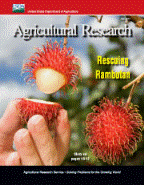United States Department of Agriculture: Agricultural Research Service, Lincoln, Nebraska

Agricultural Research Magazine
Date of this Version
7-2013
Document Type
Article
Citation
Agricultural Research July 2013.
Abstract
Fungi are a large and diverse group of organisms. Some fungi, like mushrooms, are edible and considered crops. Others, however, can cause serious diseases of crop and forest plants, and those diseases can have negative effects on local and international economies as well as on the supply of food and other materials that agriculture provides.
The Agricultural Research Service maintains a unique resource—the U.S. National Fungus Collections—for helpful and detailed information about fungi. Accurate knowledge of fungi is critical for controlling the diseases they cause.
North America’s Largest Fungarium
In 1869, the Smithsonian Institution transferred its fungal collection to the U.S. Department of Agriculture. It later became the Mycological Collections and finally the U.S. National Fungus Collections.
“The collection had fewer than 3,000 specimens in 1885. It has grown to more than 1 million collected specimens and is the largest fungarium in North America today,” says Amy Rossman, research leader of the Systematic Mycology and Microbiology Laboratory (SMML) in Beltsville, Maryland. “It is important that this long-standing resource be available because species and science are not static, and you can never go back in time and space. Many fungal species can be lost either through competition or habitat loss, so having this collection will become increasingly important.”
When producers are faced with a fungus problem in their crops, the U.S. National Fungus Collections, its curator, and the scientists who work most directly with the collection are often the first contacts made. SMML biologist Shannon Dominick serves as the collection manager, receiving, cataloging, maintaining, and providing samples of fungi.
“When this collection was started more than 100 years ago, no one had an inkling of how DNA worked or its scientific importance,” says Dominick. “Now, DNA is extracted to definitively identify fungal species that may be new or those that have been sitting in the collection for years. It is imperative that this collection be available for future scientific technologies that may help agricultural scientists and producers maintain health of a crop.”
Included in
Agriculture Commons, Animal Sciences Commons, Food Science Commons, Plant Sciences Commons

